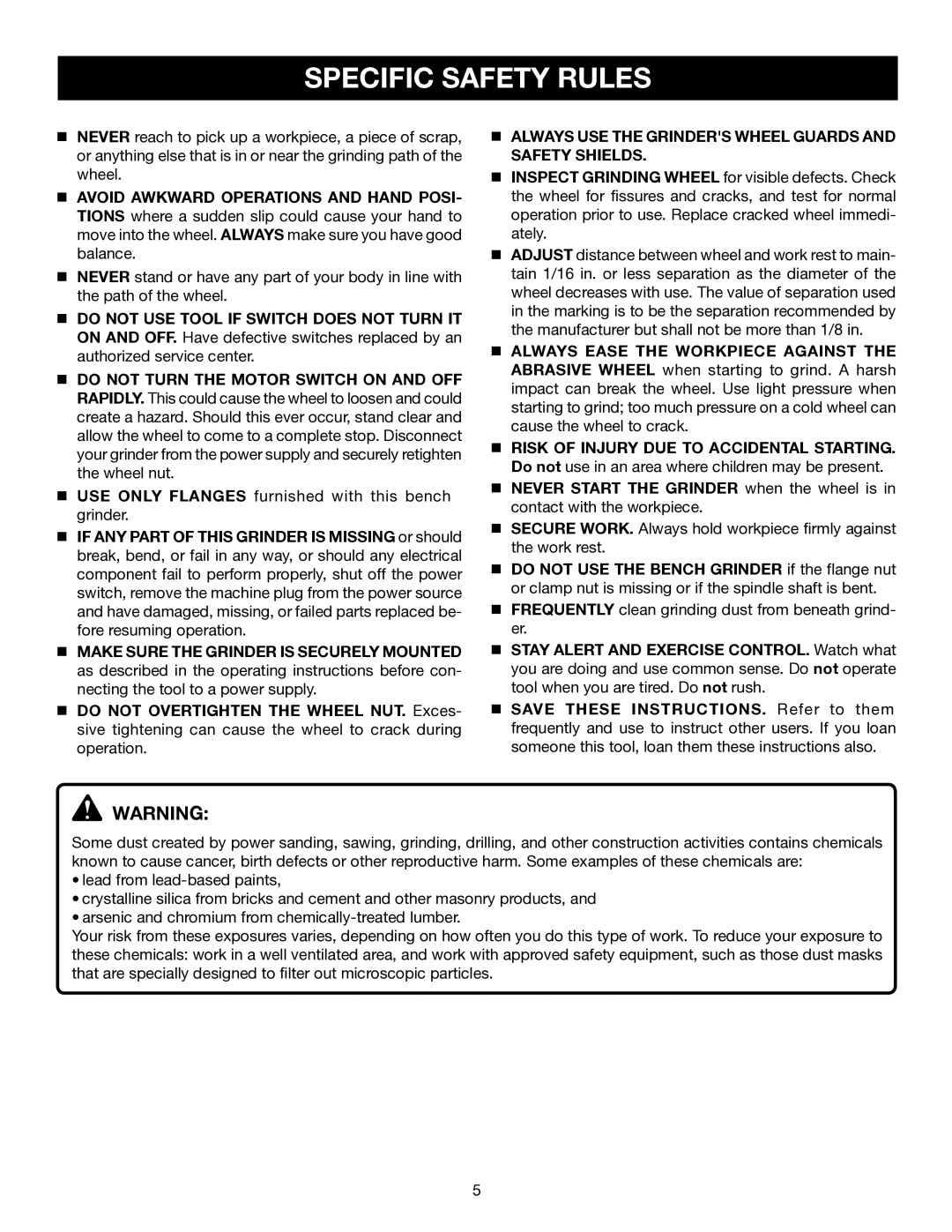
SPECIFIC SAFETY RULES
nNEVER reach to pick up a workpiece, a piece of scrap, or anything else that is in or near the grinding path of the wheel.
nAVOID AWKWARD OPERATIONS AND HAND POSI- TIONS where a sudden slip could cause your hand to move into the wheel. ALWAYS make sure you have good balance.
nNEVER stand or have any part of your body in line with the path of the wheel.
nDO NOT USE TOOL IF SWITCH DOES NOT TURN IT ON AND OFF. Have defective switches replaced by an authorized service center.
nDO NOT TURN THE MOTOR SWITCH ON AND OFF RAPIDLY. This could cause the wheel to loosen and could create a hazard. Should this ever occur, stand clear and allow the wheel to come to a complete stop. Disconnect your grinder from the power supply and securely retighten the wheel nut.
nUSE ONLY FLANGES furnished with this bench grinder.
nIF ANY PART OF THIS GRINDER IS MISSING or should break, bend, or fail in any way, or should any electrical component fail to perform properly, shut off the power switch, remove the machine plug from the power source and have damaged, missing, or failed parts replaced be- fore resuming operation.
nMAKE SURE THE GRINDER IS SECURELY MOUNTED as described in the operating instructions before con- necting the tool to a power supply.
nDO NOT OVERTIGHTEN THE WHEEL NUT. Exces- sive tightening can cause the wheel to crack during operation.
nALWAYS USE THE GRINDER'S WHEEL GUARDS AND SAFETY SHIELDS.
nINSPECT GRINDING WHEEL for visible defects. Check the wheel for fissures and cracks, and test for normal operation prior to use. Replace cracked wheel immedi- ately.
nADJUST distance between wheel and work rest to main- tain 1/16 in. or less separation as the diameter of the wheel decreases with use. The value of separation used in the marking is to be the separation recommended by the manufacturer but shall not be more than 1/8 in.
nALWAYS EASE THE WORKPIECE AGAINST THE ABRASIVE WHEEL when starting to grind. A harsh impact can break the wheel. Use light pressure when starting to grind; too much pressure on a cold wheel can cause the wheel to crack.
nRISK OF INJURY DUE TO ACCIDENTAL STARTING. Do not use in an area where children may be present.
nNEVER START THE GRINDER when the wheel is in contact with the workpiece.
nSECURE WORK. Always hold workpiece firmly against the work rest.
nDO NOT USE THE BENCH GRINDER if the flange nut or clamp nut is missing or if the spindle shaft is bent.
nFREQUENTLY clean grinding dust from beneath grind- er.
nSTAY ALERT AND EXERCISE CONTROL. Watch what you are doing and use common sense. Do not operate tool when you are tired. Do not rush.
nSAVE THESE INSTRUCTIONS. Refer to them frequently and use to instruct other users. If you loan someone this tool, loan them these instructions also.
![]() WARNING:
WARNING:
Some dust created by power sanding, sawing, grinding, drilling, and other construction activities contains chemicals known to cause cancer, birth defects or other reproductive harm. Some examples of these chemicals are:
•lead from
•crystalline silica from bricks and cement and other masonry products, and
•arsenic and chromium from
Your risk from these exposures varies, depending on how often you do this type of work. To reduce your exposure to these chemicals: work in a well ventilated area, and work with approved safety equipment, such as those dust masks that are specially designed to filter out microscopic particles.
5
